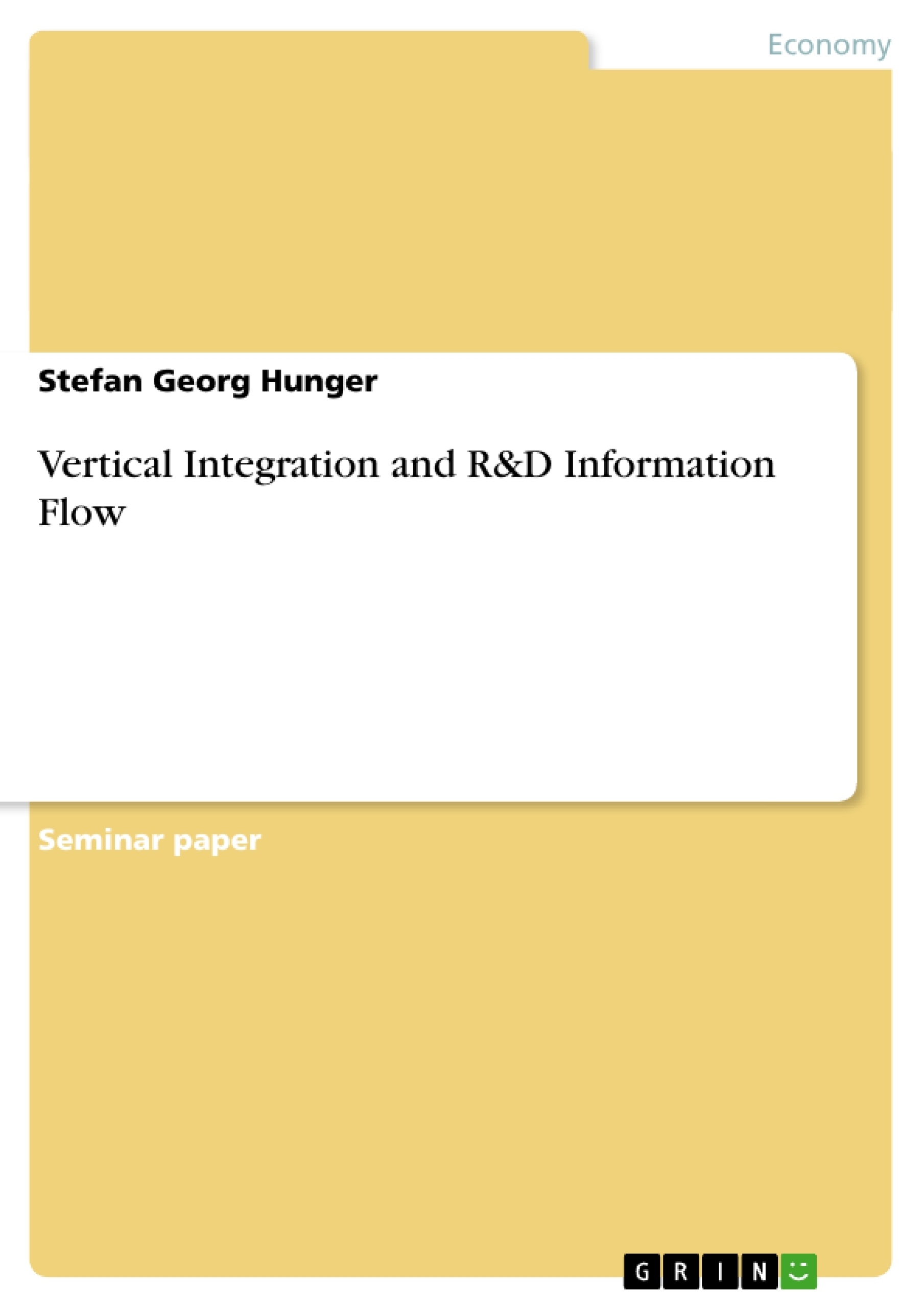In explaining the reasons for the large number of mergers among multinational companies as well as small specialized businesses in recent years, the realization of potential synergies among the merging firms has often been pointed out. Synergy is a ‘Holy Grail’ of business strategy; many seek it but few actually succeed and most attempts at developing synergies meet at a non desirable fate. A global survey of A.T. Kearney (1998) concluded that after three years of a transaction the profitability of the integrated firm decreases by 10 % on average and 50 % of alliances in the USA fail within four years.
Nevertheless, it is particularly claimed that a vertical integration will enable the supplier to adapt his technology in a much higher degree to the needs of his customer than when he is separately owned . A world-wide study of Arthur Andersen elaborated on the factors which firms look upon when striving for merging with another company.
Content
I. Introduction
II. The basic model
III. Equilibrium analysis
IV. ‘Firewall’ versus information flow
V. Welfare analysis
VI. Conclusion
VII. Bibliography
I. Introduction
In explaining the reasons for the large number of mergers among multinational companies as well as small specialized businesses in recent years, the realization of potential synergies among the merging firms has often been pointed out. Synergy is a ‘Holy Grail’ of business strategy; many seek it but few actually succeed and most attempts at developing synergies meet at a non desirable fate. A global survey of A.T. Kearney (1998) concluded that after three years of a transaction the profitability of the integrated firm decreases by 10 % on average and 50 % of alliances in the USA fail within four years.
illustration not visible in this excerpt
Nevertheless, it is particularly claimed that a vertical integration will enable the supplier to adapt his technology in a much higher degree to the needs of his customer than when he is separately owned[1]. A world-wide study of Arthur Andersen elaborated on the factors which firms look upon when striving for merging with another company.
illustration not visible in this excerpt
The economic theory of property rights commenced with the seminal article by Coase [2] (1960) in which he demonstrated that the social desirability of the outcome was invariant to the initial distribution of property rights, so long as the various participants in an industry were able to contract with one another to move property rights to their most efficient location. Following the contributions on property rights of Sanford J. Grossman and Oliver D. Hart [3] (1986), Patrick Schmitz and Dirk Sliwka from the University of Bonn analysed the impact of ownership structures on the realization of synergies and conclude under which circumstances potential synergies can be realized.
Aloof from this scientific - managerial point of view, the Antitrust Division of the Department of Justice (DOJ) and the Federal Trade Commission (FTC) of the United States have intervened in a series of vertical merger cases in order to prevent that non-public information obtained by a vertically integrated firm (i.e. information about design, technological specifications, marketing strategies etc.) could be used anticompetitively. Moreover, the Antitrust Authorities fear that the information acquired by the upstream supplier through its vertical integrated subsidiary will lead to a reduction in innovation incentives and downstream competition.
Apart from the importance of innovations as a means of non-price competition the Authorities recognized R&D as a source of welfare gains. Especially in typically R&D intensive industry sectors such as defence, telecommunications and pharmaceuticals, these mergers are of special concern for the FTC and the DOJ and there have been a number of cases in which the Authorities intervened:
- Boeing/Rockwell
- Boeing/General Motors
- Lockheed/Loral
- PacifiCorp/Energy Group, etc.
In these merger cases information transfer was assumed to reduce competition and innovation incentives and therefore the Antitrust Authorities allowed the vertical merger but imposed the implementation of a ‘firewall’ between the merging parties. This prohibits the vertically integrated firm from communicating about non-public information.
However, it is questionable if the implementation of ‘firewalls’ can be successful and, on the other hand, whether the information flow really reduces innovation incentives and social welfare. In fact there are cases in which an increasing concentration even improved R&D intensity. Moreover weakening the arguments of the Authorities, Richard T. Rapp, President of the National Economic Research Associates, Inc., argued in a critique of the Innovation Market Approach in Mergers (1995): “The incentive to collude to reduce R&D output is much weaker than the incentive to collude over prices in product markets. R&D-restricting agreements are inherently less stable than price cartels.”
To channel the ongoing discussion into a scientific approach this causa interroganda can be analysed following Chrysovalantou Milliou [4] with a simple model in which a vertically integrated firm has the monopoly in the upstream market and at the same time competes in the downstream market with a non-integrated firm.
[...]
[1] Schmitz, P.W., Sliwka, D.: On Synergies and Vertical Integration; International Journal of Industrial Organization, 1999, 1281-1282.
[2] Coase, R.: The Problem of Social Costs; Journal of Law and Economics, 1960.
[3] Grossman, S.J., Hart, O.D.: The Costs and Benefits of Ownership: A theory of vertical and lateral integration; Journal of Political Economy, 1986, 691-719.
[4] Department of Economics, European University Institute, Florence, Italy; Department of Economics, Universidad Carlos III de Madrid, Madrid, Spain.
- Quote paper
- Stefan Georg Hunger (Author), 2004, Vertical Integration and R&D Information Flow, Munich, GRIN Verlag, https://www.grin.com/document/44826
-

-

-

-
Upload your own papers! Earn money and win an iPhone X. -

-
Upload your own papers! Earn money and win an iPhone X. -

-
Upload your own papers! Earn money and win an iPhone X. -

-
Upload your own papers! Earn money and win an iPhone X. -

-
Upload your own papers! Earn money and win an iPhone X. -

-
Upload your own papers! Earn money and win an iPhone X.

